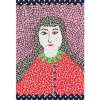Mt.
Fuji
This collection of Yayoi Kusama’s prints radiates the artist’s awe when encountering Mount Fuji. After a long tradition of Japanese artists who have paid homage to the monumental single peak, many of the prints were produced laboriously as woodcuts, though she also produced a lithographic representation.
Yayoi Kusama Mt. Fuji For sale
Mt. Fuji Value (5 Years)
Works from the Mt. Fuji series by Yayoi Kusama have a strong market value presence, with 83 auction appearances. Top performing works have achieved standout auction results, with peak hammer prices of £55971. Over the past 12 months, average values across the series have ranged from £15573 to £46193. The series shows an average annual growth rate of 7.75%.
Mt. Fuji Market value
Auction Results
| Artwork | Auction Date | Auction House | Return to Seller | Hammer Price | Buyer Paid |
|---|---|---|---|---|---|
Mt. Fuji In Seven Colours - When Life Boundlessly Flares Up To The Universe Yayoi Kusama Signed Print | 17 Jul 2025 | Mallet Japan | £38,250 | £45,000 | £50,000 |
Mt. Fuji In Seven Colours - All Things Full Of Kindness Touched My Heart Yayoi Kusama Signed Print | 12 Jul 2025 | SBI Art Auction | £25,500 | £30,000 | £35,000 |
 Mt. Fuji Yayoi Kusama Signed Print | 23 May 2025 | SBI Art Auction | £12,750 | £15,000 | £18,000 |
Mt. Fuji In Seven Colours - Where Our Soul Sets In, This Dark Mountain Embraces All With Love Yayoi Kusama Signed Print | 15 May 2025 | Mallet Japan | £23,800 | £28,000 | £35,000 |
Mt. Fuji In Seven Colours - All About Mt. Fuji That I Have Loved My Whole Life Yayoi Kusama Signed Print | 6 Mar 2025 | Mallet Japan | £22,950 | £27,000 | £30,000 |
Mt. Fuji In Seven Colours - Where The Universe And Human Life Are Yayoi Kusama Signed Print | 22 Feb 2025 | New Art Est-Ouest Auctions Co. | £29,750 | £35,000 | £45,000 |
Sell Your Art
with Us
with Us
Join Our Network of Collectors. Buy, Sell and Track Demand
Meaning & Analysis
This collection of Yayoi Kusama’s prints radiates the artist’s awe when encountering Mount Fuji. After a long tradition of Japanese artists who have paid homage to the monumental single peak, many of the prints were produced laboriously as woodcuts, in addition to a lithographic representation.
Born in Matsumoto City, 1920s Japan, Yayoi Kusama studied Nihonga painting at the Kyoto City University of Art. Nihonga is a style of art, developed around the turn of the 20th Century which rigidly followed traditional Japanese and formalistic ways of painting in an effort to counterbalance the growing influence of Western art in the country. Translated literally, Nihonga means ‘Japanese painting’. This collection of prints then, in their traditional and proudly nationalist subject and composition, sees Kusama harking back to her early training, but inevitably with her own personal twist.
In the lithograph Mt. Fuji, from 1983, Mount Fuji is given volume using her signature polka dots. Cleverly concentrating larger dots towards the centre of the mountain and radiating smaller dots away from this point, she effectively creates dimensionality. This choice creates a perspectival depth that is not felt in traditional paintings and woodcuts of the mountain. Traditionally depth is limited to the gentle juxtaposition of fore and backgrounds in Japanese art, which uses haziness and the subtle difference in pastel shades to do so. Kusama’s print does not limit itself to subtlety: adding depth to within the background, to the mountain itself, she makes the summit appear to ‘jump forward’ at the viewer, creating an impression of its sublime vastness and impact. Her colour palette, too, defies tradition, as she uses vivid blues and greens to create a picture postcard view of the mountain, in her 2015 woodcut series Mt. Fuji In Seven Colours.

















